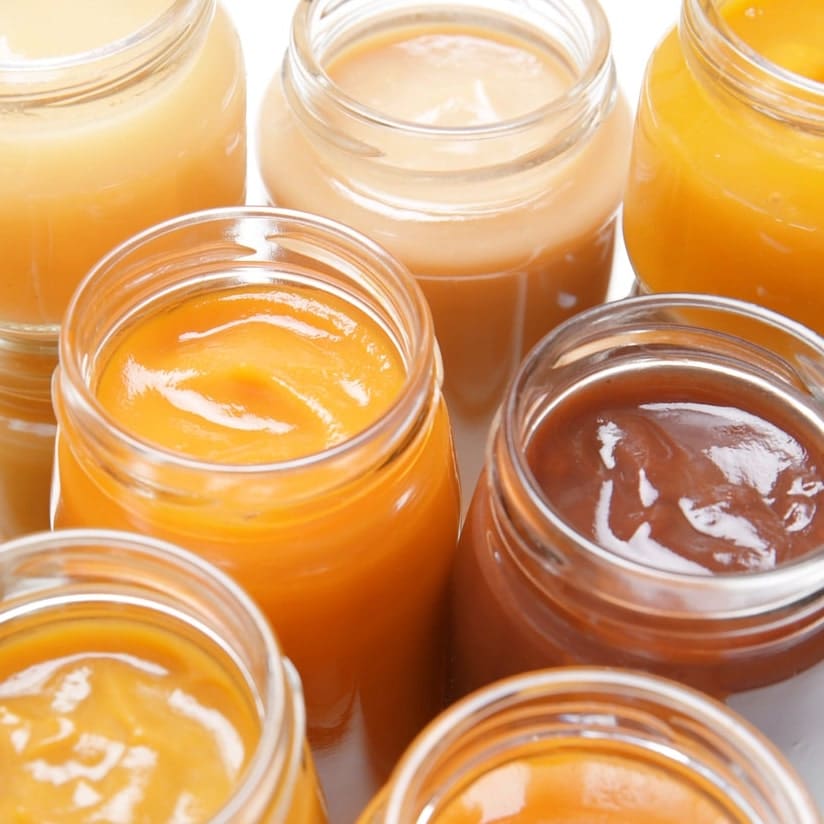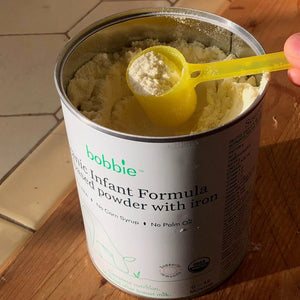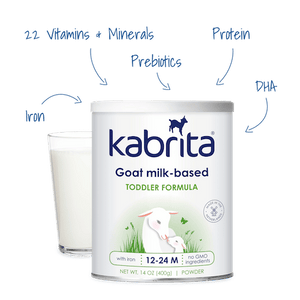Gimme the Good Stuff’s Take on the Report
Hopefully, Dr. Hopkins’ summary above helps you understand exactly what’s happened. What follows are his and my major insights and suggestions on what to do:
1. No evidence suggests that these four “bad” companies (Gerber, Earth’s Best, HappyBABY, and Beech-Nut) are exceptional in any way when it comes to heavy metal contamination. Rather, they are examples of a much larger problem that applies to all baby food.
Some news articles gave the impression that these four companies are somehow uniquely reckless (CNN wrote that “four leading baby food manufacturers knowingly sold baby food that contained high levels of toxic heavy metals,” for instance.) Remember that the congressional committee only asked seven companies for data and the four who submitted data were actually the ones being compliant, whereas the other three were flat out uncooperative–and then of course you still have the dozens of other baby food manufacturers who were never asked to submit data at all.
2. Trying to rank these companies into Good, Bad, and Sneaky Stuff based on this report is like comparing apple (juice) to oranges.
Several different metrics are used to report levels of heavy metals across all these brands and from one product type to another, making it virtually impossible to compare them directly. For example Nurture (HappyBABY) is the only baby food manufacturer that appears to regularly test its finished baby food products, whereas the others only test ingredients. And as the 2019 secret report from Hain showed us, you cannot accurately predict heavy metal levels in the final product based on ingredient calculations.
3. Although we can’t give a definitive ranking of which companies are Good, Bad, or Sneaky, below are the notable headlines for each of these companies, (according to the report), which you can use to draw some value comparisons between brands:
- Nurture (HappyBABY) gets a particularly pointed critique in the report, despite being the only company that routinely tests the final product (as opposed to just testing ingredients), because they said outright in their letter to the subcommittee that “our heavy metal testing is performed as part of our monitoring program and not as a condition of product release, all of the products that were tested were sold into commerce.” In other words, they stated plainly that they will sell everything regardless of heavy metal content. Furthermore, Nurture gets called out for basically lying to the committee about it’s testing, claiming that they used a goal standard of 50 ppb lead after January 2019, and then later submitting test documents showing a goal standard of 100 ppb.
- Beech-Nut set internal arsenic and cadmium standards at 3,000 ppb in dangerous additives, such as their vitamin mix, and 5,000 ppb lead for certain ingredients like BAN 800. These standards are the highest of any responding manufacturer. The report points out that although Beech-Nut stated in their letter that they “rarely” accepted ingredients that failed to see their internal standards, the data they submitted contradicts that with several examples of accepted and sold ingredients that far surpassed standards (cadmium levels in their dehydrated sweet potato, for example).
- Hain (Earth’s Best Organics) appears to deserve some credit for being the whistleblower, even though they themselves are guilty of selling baby food with dangerous levels of heavy metals. They were the ones to point out that the current manufacturer practice of testing only ingredients (rather than finished product) clearly under-counts levels of toxic heavy metals present in the final products. Like all manufacturers, Hain was called out in the report for setting its own dangerously high internal standards, and then routinely accepting ingredients that surpassed these standards, as well as continuing to do so AFTER giving their secret presentation to the FDA about these risks.
- Of the four companies who released data for the report, Gerber (surprisingly) comes off as the least guilty of gross negligence. For each of the specific heavy metals listed, the examples of Gerber ingredients’ metal levels appear relatively low compared to the other manufacturers, and they are the only company that does not get specifically called-out for some particular example of gross recklessness. That said, the report does list many examples of ingredients with high heavy metal concentrations; for example, Gerber used 67 batches of rice flour with over 90 ppb of inorganic arsenic.
- Don’t forget that Campbell Soup Company (Plum Organics), Walmart Inc. (Parent’s Choice), and Sprout Foods, Inc. (Sprout Organic Foods) did not comply with the request for data, so I am deeming them ALL Sneaky Stuff.
4. Nothing about these alarming levels of toxic heavy metals is unique to baby foods.
The reason baby food is important in this discussion is because of the significantly increased health risks that babies face from heavy metals, due to their developmental stage and small bodies. Giving your baby adult foods does not solve this issue, unfortunately. There are, however, many things you CAN do to try to limit your baby’s exposure to heavy metals, while we wait for FDA regulation to catch up with current scientific data/standards. This article provides great details on how to avoid these ingredients.
5. In general, these contaminants come from the raw ingredients, not the manufacturing process.
Unfortunately, heavy metals can occur naturally in certain raw ingredients, and in the environment. It’s worth noting that this is a much bigger problem now than it was before the 1940s when we began a decades-long assault on our soil, covering arable land with heavy-metal rich fertilizer and pesticides. It’s really a challenge to take them out in some cases, and that’s part of the FDA’s defense as to why there aren’t stricter guidelines. However it doesn’t change the main point about creating laws and policies that prevent these raw ingredients from being used in baby food in the first place (rather than just searching for ways to reduce the heavy metals in the ingredients) and secondly, give the consumer enough information to make an informed choice.
6. But…”naturally occurring” heavy metals may not be the only source of unsafe levels of these toxins, and we should be aware of certain problem ingredients.
The report identifies a handful of specific ingredients that had extremely high levels of certain heavy metals, and even though these ingredients might make up a very small percentage of the final product, it appears they may be driving the overall numbers up much more than pre-production calculations would predict. The specific problematic ingredients that were highlighted in the current report include: cinnamon, amylase, BAN 800, and vitamin/mineral premix. When Dr. Hopkins first presented me with this information, I thought, how is this any different from the arsenic in rice and foods? The difference is that rice is a whole food that might make up 50% or more of a final product and also tends to have high levels of arsenic—perhaps even exceeding 100 ppb. On the other hand, the specific problematic ingredients would typically only comprise a very small amount of finished product (1-2% or less), however the report shows that the levels of heavy metals in these ingredients is orders of magnitude (100’s to 1000’s ppb) higher than what you would find in rice or a sweet potato, for example. So while the report suggests that we should reconsider whether to include rice in baby foods, the authors are also pointing out that a separate but related task is to identify trace ingredients such as those listed above and remove them entirely from the baby food supply chain.
7. More than anything else, this report emphasizes the lack of effective regulation by the FDA, and is a major call to action.
If you take only one thing away from this post, let it be this: the data from this report highlights an inexcusable lack of action from the FDA (specifically, following the formation of a special task force in 2017 to address this issue, and in response to Hain’s whistleblower presentation in 2019) and an urgent need to address this public health concern. As you read above, the report goes through each of the heavy metals and points out how limited and random the guidelines are. The clearest example of the inconsistency from the FDA is that drinking water has a maximum of 1-10 ppb for all of these toxic heavy metals, but then only a handful of specific foods have set limits and generally they are much much higher. Or we could use arsenic as another example. The maximum allowable limit or inorganic arsenic in drinking water is 10ppb. Only two other items have arsenic limits- infant rice cereal and apple juice. In other words, the only category of “baby food” that has an arsenic limit is infant rice cereal–and the limit is 100 ppm. Apparently, this limit is based on the risk of causing cancer, rather than neurotoxicity or any other adverse health outcomes. If we look at the only other item with a specific limit, we see that apple juice is capped at 10 ppb. This is a great start for apple juice but does nothing at all to address levels of arsenic in other juices, or anything else at all for that matter. And yes, arsenic IS present in other juices. For example, Gerber’s data shows a grape juice concentrate with 39 ppb inorganic arsenic, but there are no FDA guidelines at all regarding arsenic in grape juice or any other juice besides apple.
Nine Steps You Can Take to Reduce Your Family’s Risk
- Know your farmer. While all of our air and soil is contaminated by some amount of heavy metal, growing your own produce or buying from an organic farm you trust may reduce the amount you’re consuming. Dr. Hopkins agrees that “it makes sense that soil that was never commercially farmed should be less contaminated with heavy metals.”
- Reduce your consumption of the dirtiest foods. Unfortunately, many otherwise healthful foods are some of the most contaminated with heavy metals. Farmed fish is a major offender, and large fish like tuna and swordfish are very high in mercury. (Better fish options include trout, sockeye salmon, and sole.) Brown rice contains up to 80% more arsenic than white rice, so when you do eat rice, you should consider choosing white. Sadly, leafy green vegetables are often contaminated with cadmium. Other high-risk vegetables include potatoes, carrots, radishes, onions, lettuce, mint, and cilantro.
- Choose the right rice–and cook it like pasta. White basmati rice from California, India, or Pakistan has been shown to have the lowest levels of arsenic. If you cook rice the same way that you cook pasta–in a large amount of water and then draining it–you can get rid of more than half the arsenic it contains.
- Minimize snacks foods for your baby. Snack foods were particularly bad in this report–including crackers, puffs, and teething biscuits. To the degree that you can avoid these (and I know this is hard!), you should. Here are some healthier snack ideas. Beans have lower levels of heavy metals than other snacks.
- Eat a variety of foods. A diverse diet is beneficial for many reasons, and feeding your kids a range of whole foods will ensure that they aren’t getting too much of any one ingredient (and its potential contaminants). Meat and dairy–while not without their own issues–are less likely to be contaminated with heavy metals. And some fruits and vegetables–zucchini, broccoli, artichokes, tomatoes, peppers, beans, cauliflower, apples, avocados, bananas, grapes, peaches, and strawberries–are lower in heavy metals.
- Make your own baby food. As mentioned above, this won’t eliminate heavy metals in your baby’s diet, because plenty of whole foods naturally contain high levels of heavy metals. I would skip rice cereal all together, though, and here are our resident health coach’s suggestions for rice cereal alternatives. Oatmeal is a healthier alternative to rice cereal.
- Skip juice entirely. Apple and grape juice are among the worst foods when it comes to arsenic. There’s no reason toddlers need juice at all–so this is just a good reminder to stick to water as much as possible.
- Peel produce. If you peel a sweet potato, you’ll reduce the heavy metals significantly, especially if you peel a little deeper than you might normally.
- Filter your water. Installing a robust water filter is one of the simplest ways to reduce your family’s exposure to heavy metals. Here’s how to choose the right filter.
The bottom line is that while there are steps we can take as consumers (and manufacturers), the most important action going forward must come from the FDA. Consider signing this this petition or contact your local and state representatives to demand action at the government level.








